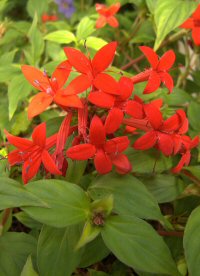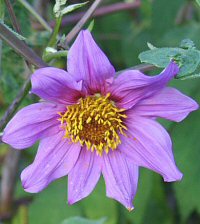New 2011 Introductions
New introductions primarily from our own wild seed collections that will become available during the course of the new season. Here divided into 3 sections:
New cultivar names we are allocating or introducing
Temporary text for you to see while we construct our 2011 introductions
Aspidistra daibuensis 'Totally Dotty' BSWJ3236
A distinct form of this species, which we have grown for many years, originating from a single plant we selected from the forest overlooking the South Cross Highway, southern Taiwan, which was still only a track at that time in 1996. This form was distinct amongst the colony we found by the broad oblong-lanceolate leaves being more heavily spotted and streaked in white than any others, to 1 m tall. This species grows quite happily for us in well drained dark shade out of doors sheltered from freezing winds. Avoid sodden soil/composts.

Aspidistra daibuensis 'Tidy Trim' BSWJ6866
A smaller form of this Taiwanese species we found in 1999 in the south of Hualien County, where it grew on the edge of the path. Under these conditions the leaves were only 10cm long while the habit was tight, forming a dense carpet of lightly spotted leaves. After cultivating since that time the leaves have become much larger closer to 60cm long, but narrow to only 5-7.5cm, while retaining the dense habit.
Crusea coccinea ‘Crûg Crimson’ BSWJ10254
From a family of plants seldom seen as hardy, a prostrate growing creeping woodlander with fresh green small ribbed leaves on slender reddish rooting stems. Bearing bright red long trumpet-flowers in axillary clusters for month during the summer. One of our collections gathered from the high mountain forests of Oaxaca southern Mexico in 2004. Easily grown in sheltered full to part shade in a freely drained soil with some humus for moisture retention, or kept frost free in a container.

Dahlia excelsa ‘Penelope Sky’ BSWJ10233
A stunning clump-forming perennial, where we found this species growing on the moist mountains to the east of Oaxaca southern Mexico in 2004 at around 2500m. Where it formed formidable clumps of strongly upright, almost bamboo-like bloomy stems to over 3m tall with several opposite branches from the shallowly cup-shaped nodes, in the upper parts bearing bronzy pinnate foliage and large lilac-purple ray flowers from July to frost. For a sunny warm spot in moist but drained fertile soil, best protected from severe frost, hardy for us in a field with a decent mulch. Named for our youngest granddaughter born April 1st 2009.

Tricyrtis latifolia ‘Saffron’ BSWJ10996
An easily distinguished selection of this species that has arisen from one of our seed collections gathered in 2005 from a shaded steep slope in the Niigata district of western Japan. It is easily distinguished from any other form of T. latifolia, as the pale yellow flowers are lacking any of the normal red spotting on the interior of the spreading tepals or the stigmas, a feature which is unknown in cultivation in Japan, from what my reliable sources tell me. Meanwhile the plant is as normal in being one of the easiest to cultivate and the earliest species into flower, forming clumps of erect stems to 80cm tall clothed in broad glossy leaves which are dark spotted when they emerge. Bearing good-sized yellow upwardly inclined flowers in cymes from the upper axils, from June-September. Named for my daughter Saffron, who has borne us two wonderful grandsons, Vannin and Iago. ** We hope to be able to offer this plant within the next couple of years, when we have built up sufficient stocks.

Viburnum cylindricum 'Chino-Crûg’ BWJ7778
Easily distinguished from the rest of this species, in that it is much smaller in habit, with smaller leaves and stature. Also it is much earlier to come into flower than any other form we cultivate, for us opening its wide cymes of white cylindrical flowers by mid-summer. Hence forming the small purple berries by late summer, at which time our other forms are starting to flower. The collection appeared distinct in the wild, with decidedly serrated margins to the small ovate almost orbicular grey wax covered leaves on small shrubs to less than 2m tall. At 3100m the highest elevation we have found this species growing. In an area close to Lijiang in western Yunnan China where this shrub was plentiful in 2000.
